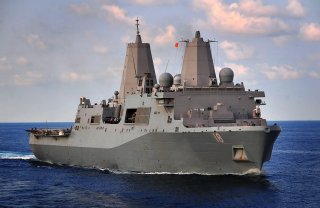Could an American Great Wall Hold Back the PLA Navy?
Build the wall—and educate the sentries destined to guard it.
Now, it’s doubtful whether Beijing would content itself with forcing a single passage and the islands overshadowing it. Alfred Thayer Mahan deprecates maritime powers that have only one access point to the high seas. Their poverty of access exposes them to blockade and desolation. To forestall such a fate, Chinese strategy might seek to blow open a wide arc in the first island chain, diversifying China’s geostrategic portfolio. Suppose the Miyako Strait were the principal target of a maritime assault. Rather than settle for momentary control of the strait, PLA forces might swing north toward Okinawa and the Japanese home islands or south toward Taiwan. Sweeping along the island chain would hand them control of multiple islands and straits—easing China’s Mahanian plight.
Which would it be? A southerly turn appears far more promising. Going north would probably demand that the PLA first subdue Okinawa, home to powerful U.S. and Japanese air forces. It would certainly mean approaching the Japanese home islands, the seat of U.S.-Japanese armed might. Clausewitz warns of the perils of plunging into an enemy’s territory, where the enemy enjoys advantages conferred by dense military resources and proximity to likely scenes of action. His admonition would hold sway in an island-chain war even if PLA forces island-hopped around Okinawa the way General Douglas MacArthur bypassed Japanese fortresses such as Truk and Rabaul three-quarters of a century ago. Worse, it would leave Okinawa-based air and sea forces to the rear of the advancing PLA vanguard.
A forbidding prospect. A pirouette toward Taiwan, by contrast, would aim the Chinese campaign toward weakness—elongating allied logistics while interposing PLA forces between the targeted islands and forces coming to their relief from Okinawa or the home islands. In that case, battlefield dynamics would gladden the hearts of Chinese commanders and officialdom. Success in a southerly venture would ameliorate China’s access problem. As a side benefit, it would drive a salient into the Pacific Ocean, granting the PLA positions to Taiwan’s north and astride the sea lanes to Japan’s south. Positions bestow influence. This is an operational option with allure.
And fourth, it’s worth noting that China will have the initiative in island-chain combat. Perimeter defense is a mostly static affair. It has “negative aims,” as Clausewitz would put it, meaning it strives to keep a foe from taking something away rather than trying to take something from the foe. Hence it involves awaiting blows. The negative attitude underlying perimeter defense opens up a menu of options for an enterprising antagonist.
Menus list delicacies. Master of deception Barton Whaley observes that a force that can plausibly pursue more than one objective puts its enemy on the horns of a dilemma. It compels enemy commanders to choose between dispersing forces in a bid to protect all potential objectives and guessing at the one true objective and committing resources to defend it. Guess wrong and you could lose it all. Or as General William Tecumseh Sherman once encapsulated his battlefield strategy: put your opponent on the horns of a dilemma, then gore him with one of them!
In a way, U.S. Navy war planners had it easy during the interwar decades. They could afford to assume the United States would lose Far Eastern possessions of less than paramount importance, chiefly the Philippines and Guam, at the outset of a Pacific war against Japan. This simplified matters. Raw facts of power let them concentrate on explaining how U.S. joint forces should fight their way back into the Western Pacific to retake these possessions and starve out Japan. War Plan Orange and its successors were the result.
Today, though, the United States cannot afford to surrender its commitments in East Asia. An early defeat could see China conquer Taiwan, wrench the Senkaku Islands from Japan, or otherwise order things to Beijing’s liking and Washington’s detriment. Allies would lose faith in U.S. martial prowess and might accommodate themselves to the wishes of a strongman China. The alliance system would falter, and America’s strategic position with it.
Deployed forces, then, must stand until the U.S. Pacific Fleet and affiliated forces can battle their way into the arena to join them. Like their Plan Orange forerunners, war planners today must figure out how to crack the access-denial problem. But they must also shoulder the burden of figuring out how to balk Chinese strategy—and deny Beijing the fait accompli it craves—until the cavalry thunders to the rescue.
Revisiting the basics of perimeter defense would make a good start. After all, a reverse Great Wall is an inert obstacle without wily defenders. Build the wall—and educate the sentries destined to guard it.
James Holmes is J. C. Wylie Chair of Maritime Strategy at the Naval War College. The views voiced here are his alone.
This article first appeared in March 2019 and is being reprinted for reader interest.
Image: Flickr

